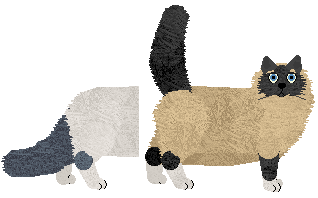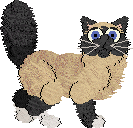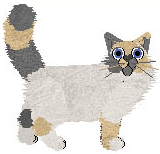A cat of mystery and legend, the Birman is a pointed cat with a long, silky coat and pure white feet. Breed folklore is elaborate, talking about how the first Birman, a yellow-eyed white cat with dirty feet named Sinh saved his master Kittah Mun-Ha from night raiders. For his bravery and loyalty, Sinh was transformed by the goddess Tsun Kyan-Kse: his body turned golden, his eyes became blue, and his paws changed to white from the soiled brown of the earth as his master’s holy aura purified them. Sinh stayed with his master until he died, carrying Mun-Ha’s soul to paradise, and seven days later the temple priests returned to discover that every temple cat had been blessed with the same sacred white feet and sapphire eyes. They were then exported under the name “Sacred Cat of Burma”, a name by which they are still known, particularly in Europe where the French name remains Chat sacré de Birmanie.
In reality, the Birman was probably the result of crossing Burmese temple cats (likely Siamese in type) imported to France with Angoras or Persians at the turn of the century, and the breed was largely reconstructed using Persians and Siamese after World War II. They arrived in America in 1959, and were accepted by CFA in 1967. The Birman itself, regardless of its past, certainly acts like a sacred temple cat; they are possessed of a deep personal dignity and poise, and as every Birman breeder knows, they each find their own Kittah Mun-Ha and will gladly defend him or her to the death—though today’s foes are more likely to be thunderstorms, very large coats, the dishwasher and the TV!
Type & judging remarks
It is neither svelte nor cobby, but strongly built and of a medium, semi-foreign type. The head has a distinctive Roman nose and a sweet expression. The body colour is even, with subtle shading allowed, though a strong contrast between body and point colour is desirable. In all point colours, “golden mist” is desirable; that is, a faint golden beige cast on the back and sides.












